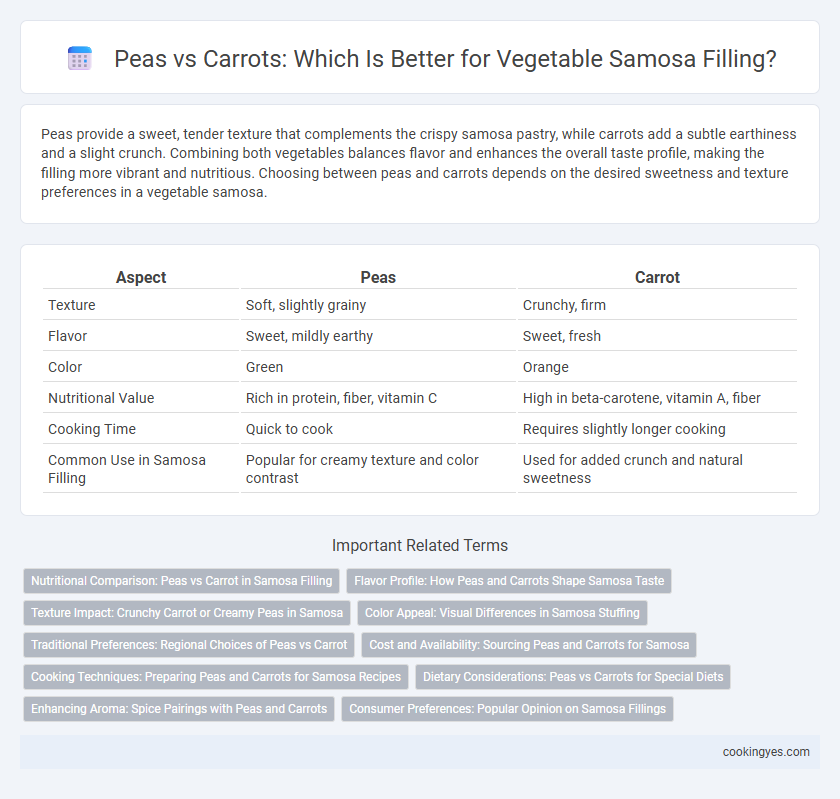Peas provide a sweet, tender texture that complements the crispy samosa pastry, while carrots add a subtle earthiness and a slight crunch. Combining both vegetables balances flavor and enhances the overall taste profile, making the filling more vibrant and nutritious. Choosing between peas and carrots depends on the desired sweetness and texture preferences in a vegetable samosa.
Table of Comparison
| Aspect | Peas | Carrot |
|---|---|---|
| Texture | Soft, slightly grainy | Crunchy, firm |
| Flavor | Sweet, mildly earthy | Sweet, fresh |
| Color | Green | Orange |
| Nutritional Value | Rich in protein, fiber, vitamin C | High in beta-carotene, vitamin A, fiber |
| Cooking Time | Quick to cook | Requires slightly longer cooking |
| Common Use in Samosa Filling | Popular for creamy texture and color contrast | Used for added crunch and natural sweetness |
Nutritional Comparison: Peas vs Carrot in Samosa Filling
Peas in samosa filling offer higher protein content and dietary fiber, enhancing satiety and digestive health, while carrots contribute significant beta-carotene and vitamin A, supporting immune function and vision. Peas provide approximately 5 grams of protein and 7 grams of fiber per 100 grams, compared to carrots' lower protein (0.9 grams) but richer antioxidant profile with carotenoids. Choosing peas emphasizes muscle recovery and gut health, whereas carrots boost antioxidant intake and vitamin A levels in savory samosas.
Flavor Profile: How Peas and Carrots Shape Samosa Taste
Peas contribute a sweet, starchy flavor and creamy texture that enhances the overall savoriness of samosa filling, creating a mellow and slightly earthy taste. Carrots add subtle sweetness and a slight crunch, providing a fresh contrast that brightens the flavor profile and balances the spices. Together, peas and carrots create a harmonious blend of textures and flavors, making the samosa filling rich, vibrant, and satisfying.
Texture Impact: Crunchy Carrot or Creamy Peas in Samosa
Carrot in samosa filling adds a distinct crunchy texture that enhances each bite, providing a satisfying contrast to the crispy outer shell. Peas contribute a creamy and soft consistency that balances the overall mouthfeel, making the filling smooth and rich. Combining both vegetables creates a layered texture profile, blending crunchy and creamy sensations for a more complex and enjoyable eating experience.
Color Appeal: Visual Differences in Samosa Stuffing
Peas in samosa filling offer a vibrant green hue that contrasts sharply with the golden-brown pastry, enhancing the visual appeal and signaling freshness. Carrots bring a bright orange color, adding warmth and a subtle sweetness that complements other spices while providing a distinct look. Combining peas and carrots creates a colorful, visually enticing stuffing that appeals to diverse tastes and elevates the overall presentation of vegetable samosas.
Traditional Preferences: Regional Choices of Peas vs Carrot
Traditional samosa fillings vary regionally, with peas favored in North Indian recipes for their sweet, starchy texture and vibrant green color that contrasts well with the golden pastry. In contrast, some South Indian and Gujarati variations incorporate carrots, valued for their slight crunch and natural sweetness, adding depth and nutritional diversity. The choice between peas and carrots often reflects local agricultural practices and cultural taste preferences, influencing the authentic flavor profile of regional samosas.
Cost and Availability: Sourcing Peas and Carrots for Samosa
Peas are typically more cost-effective and widely available year-round compared to carrots, making them a preferred choice for samosa filling in many regions. Carrots may fluctuate in price depending on the season and local cultivation, often increasing overall ingredient costs. Sourcing peas from local suppliers reduces expenses and ensures consistent quality, while carrots might require broader sourcing strategies to maintain availability.
Cooking Techniques: Preparing Peas and Carrots for Samosa Recipes
For samosa filling, peas are typically blanched quickly to retain their vibrant color and slight crunch, ensuring a fresh texture inside the crispy pastry. Carrots are often finely grated or diced and sauteed until tender to enhance their sweetness and blend seamlessly with spices. Combining these cooking techniques balances moisture and flavor, preventing soggy samosas while delivering a rich, aromatic vegetable filling.
Dietary Considerations: Peas vs Carrots for Special Diets
Peas provide higher protein and fiber content, making them ideal for vegetarian and diabetic-friendly samosa fillings. Carrots offer lower calorie density and rich beta-carotene, suitable for weight management and immune support diets. Both vegetables contribute essential nutrients, but choosing peas or carrots depends on specific dietary goals such as glucose control or vitamin A intake.
Enhancing Aroma: Spice Pairings with Peas and Carrots
Peas in samosa filling pair exceptionally well with cumin and coriander, enhancing their sweet, earthy aroma, while carrots complement warming spices like cinnamon and garam masala, adding a subtle sweetness and depth. Combining these vegetables with fresh ginger and green chili elevates the overall fragrance, creating a balanced and appetizing aroma profile. Optimal spice pairings intensify the natural flavors of peas and carrots, making the samosa filling more aromatic and flavorful.
Consumer Preferences: Popular Opinion on Samosa Fillings
Peas are the most favored vegetable in samosa fillings, appreciated for their sweet flavor and soft texture that complements the crispy pastry. Carrots, while less common, add a subtle crunch and a mildly sweet taste that appeals to consumers seeking a healthier variation. Market surveys indicate a stronger preference for pea-filled samosas among traditional snack lovers, with carrot-inclusive options gaining traction among health-conscious buyers.
Peas vs Carrot in vegetable samosa filling Infographic

 cookingyes.com
cookingyes.com